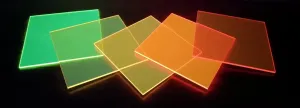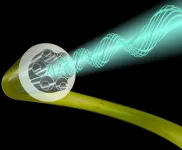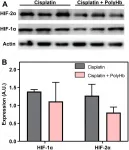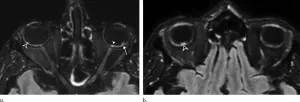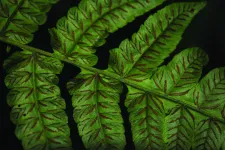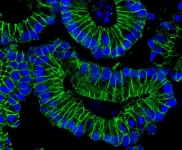(Press-News.org) HOUSTON - (Feb. 15, 2021) - Rice University engineers have suggested a colorful solution to next-generation energy collection: Luminescent solar concentrators (LSCs) in your windows.
Led by Rafael Verduzco and postdoctoral researcher and lead author Yilin Li of Rice's Brown School of Engineering, the team designed and built foot-square "windows" that sandwich a conjugated polymer between two clear acrylic panels.
That thin middle layer is the secret sauce. It's designed to absorb light in a specific wavelength and guide it to panel edges lined with solar cells. Conjugated polymers are chemical compounds that can be tuned with specific chemical or physical properties for a variety of applications, like conductive films or sensors for biomedical devices.
The Rice lab's polymer compound is called PNV (for poly[naphthalene-alt-vinylene]) and absorbs and emits red light, but adjusting the molecular ingredients should make it able to absorb light in a variety of colors. The trick is that, as a waveguide, it accepts light from any direction but restricts how it leaves, concentrating it onto the solar cells that convert it to electricity.
"The motivation for this research is to solve energy issues for buildings through integrated photovoltaics," said Li, who began the project as part of a "smart glass" competition. "Right now, solar rooftops are the mainstream solution, but you need to orient them toward the sun to maximize their efficiency, and their appearance isn't very pleasing.
"We thought, why can't we make colorful, transparent or translucent solar collectors and apply them to the outside of buildings?" he said.
The study appears in the journal Polymer International.
Admittedly, the amount of juice generated by the Rice team's test units is far less than that collected by even average commercial solar cells, which routinely convert about 20% of sunlight into electricity.
But LSC windows never stop working. They happily recycle light from inside the building into electricity when the sun goes down. In fact, tests showed they were more efficient at converting ambient light from LEDs than they were from direct sunlight, even though the sunlight was 100 times stronger.
"Even indoors, if you hold up a panel, you can see very strong photoluminescence on the edge," Li said, demonstrating. The panels he tested showed a power conversion efficiency of up to 2.9% in direct sunlight and 3.6% under ambient LED light.
Various types of luminophores have been developed over the last decade, but rarely with conjugated polymers, according to Verduzco.
"Part of the problem with using conjugated polymers for this application is that they can be unstable and degrade quickly," said Verduzco, a professor of chemical and biomolecular engineering and of materials science and nanoengineering. "But we've learned a lot about improving the stability of conjugated polymers in recent years, and in the future, we can engineer the polymers for both stability and desired optical properties."
The lab also simulated the return of energy from panels as large as 120 inches square. They reported these panels would provide somewhat less energy, but it would still contribute to a household's needs.
Li noted the polymer might also be tuned to convert energy from infrared and ultraviolet light, allowing those panels to remain transparent.
"The polymers can even be printed in patterns in the panels, so they can be turned into artwork," he said.
INFORMATION:
Co-authors are University of Washington alumnus Yujian Sun; Yongcao Zhang, a graduate assistant at the University of Houston, and Yuxin Li, a graduate assistant at the University of Cincinnati.
Solera City Energy supported the research.
Read the abstract at https://doi.org/10.1002/pi.6189.
This news release can be found online at https://news.rice.edu/2021/02/15/luminescent-windows-generate-energy-from-inside-and-out/
Follow Rice News and Media Relations via Twitter @RiceUNews.
Related materials:
Verduzco Laboratory: http://verduzcolab.blogs.rice.edu
Department of Chemical and Biomolecular Engineering: https://chbe.rice.edu
George R. Brown School of Engineering: https://engineering.rice.edu
Images for download:
https://news-network.rice.edu/news/files/2021/02/0215_SOLAR-1-web.jpg
Rice University engineers designed and built windowpanes that redirect sunlight or illumination from indoors to edge-band solar cells. The central layer is a conjugated polymer that serves as a waveguide. (Credit: Yilin Li/Rice University)
https://news-network.rice.edu/news/files/2021/02/0215_SOLAR-2-web.jpg
Rice University postdoctoral researcher Yilin Li shows a glowing windowpane with a conjugated polymer center that serves as a waveguide, sending certain frequencies of light to the edges, where it can be absorbed by solar cells. (Credit: Yilin Li/Rice University)
https://news-network.rice.edu/news/files/2021/02/0215_SOLAR-3-web.jpg
Rice University engineers designed and built windowpanes that redirect light to edge-band solar cells. The cells both sunlight and ambient light from indoors. (Credit: Yilin Li/Rice University)
https://news-network.rice.edu/news/files/2021/02/0215_SOLAR-4-web.jpg
A concept for a house using windowpanes designed by Rice University engineers to redirect light from inside and out to edge-band solar cells. (Credit: Yilin Li/Rice University)
https://news-network.rice.edu/news/files/2021/02/0215_SOLAR-5-web.jpg
Rice University engineers designed and built layered windowpanes that redirect sunlight or illumination from indoors to edge-band solar cells. (Credit: Yilin Li/Rice University)
Located on a 300-acre forested campus in Houston, Rice University is consistently ranked among the nation's top 20 universities by U.S. News & World Report. Rice has highly respected schools of Architecture, Business, Continuing Studies, Engineering, Humanities, Music, Natural Sciences and Social Sciences and is home to the Baker Institute for Public Policy. With 3,978 undergraduates and 3,192 graduate students, Rice's undergraduate student-to-faculty ratio is just under 6-to-1. Its residential college system builds close-knit communities and lifelong friendships, just one reason why Rice is ranked No. 1 for lots of race/class interaction and No. 1 for quality of life by the Princeton Review. Rice is also rated as a best value among private universities by Kiplinger's Personal Finance.
Jeff Falk
713-348-6775
jfalk@rice.edu
Mike Williams
713-348-6728
mikewilliams@rice.edu
Researchers from the University of Southampton and Université Laval, Canada, have successfully measured for the first time back-reflection in cutting-edge hollow-core fibres that is around 10,000 times lower than conventional optical fibres.
This discovery, published this week in The Optical Society's flagship Optica journal, highlights yet another optical property in which hollow-core fibres are capable of outperforming standard optical fibres.
Research into improved optical fibres is key to enable progress in numerous photonic applications. Most notably, these would improve Internet performance ...
Oncotarget recently published "Polymerized human hemoglobin increases the effectiveness of cisplatin-based chemotherapy in non-small cell lung cancer" which reported that unfortunately, a significant portion of NSCLC patients relapse due to cisplatin chemoresistance.
Administration of hemoglobin-based oxygen carriers is a promising strategy to alleviate hypoxia in the tumor, which may make cisplatin more effective.
The R-state PolyHb administered in this study is unable to deliver O2 unless under severe hypoxia which significantly limits its oxygenation potential.
In vitro sensitivity studies indicate that the administration of PolyHb increases the effectiveness of cisplatin under ...
BOSTON -- While PCR testing has been used widely for COVID-19 diagnosis, it only provides information on who is currently infected. Antibody testing can tell who has been previously exposed to SARS-CoV-2, the virus that causes COVID-19, a metric that is essential for tracking spread across a population. It may also, as a study recently published in the journal Nature Communications shows, hold the key to understanding the immune response to the virus.
Led by Galit Alter, PhD, Core Member of the Ragon Institute of MGH, MIT and Harvard, this study found that while antibodies against SARS-CoV-2 may be a good way to measure exposure to the virus, their presence alone wasn't enough to determine if a person had long-lasting protection. Instead, antibody effector functions associated ...
OAK BROOK, Ill. - Radiomics--the extraction of very detailed quantitative features from medical images--provides a refined understanding of how cocaine use and other risk factors affect the course of coronary artery disease, according to a study published in Radiology. Researchers said the study shows the power of radiomics to improve understanding of not just cardiovascular disease, but cancer and other conditions as well.
Coronary artery disease typically develops over time as plaque builds up inside the arteries. This process, known as atherosclerosis, ...
OAK BROOK, Ill. - Researchers using MRI have found significant abnormalities in the eyes of some people with severe COVID-19, according to a study published in the journal Radiology. The study results support the need for eye screening in these patients to provide appropriate treatment and management of potentially severe ophthalmological manifestations of COVID-19.
The COVID-19 pandemic has affected more than 100 million people since it began early in 2020. While the virus primarily attacks the lungs, it has been linked with eye abnormalities ...
Launched in 1988, the Global Polio Eradication Initiative (GPEI) stands out as one of the largest, internationally coordinated global public health major projects conducted to date, with cumulative spending of over $16.5 billion for 1988-2018, according to the World Health Organization (WHO). More than 30 years later, stubborn outbreaks of wild poliovirus still occur in Afghanistan and Pakistan, where cases have been increasing since 2018. The global eradication of polio continues to be an elusive goal.
A special issue of the journal Risk Analysis, titled "Global Poliovirus Risk Management and Modeling," looks at the current status of polio eradication ...
Earth is home to millions of known species of plants and animals, but by no means are they distributed evenly. For instance, rainforests cover less than 2 percent of Earth's total surface, yet they are home to 50 percent of Earth's species. Oceans account for 71 percent of Earth's total surface but contain only 15 percent of Earth's species. What drives this uneven distribution of species on Earth is a major question for scientists.
In a paper published February 16 in the Journal of Biogeography an international team of researchers led by Jacob S. Suissa, Ph.D. Candidate in the Department of Organismic and Evolutionary Biology, ...
Memorial Sloan Kettering Cancer Center (MSK) physicians and scientists presented new research at the 2021 American Society of Clinical Oncology Genitourinary Cancers Symposium held virtually February 11-13. Notably, MSK medical oncologist Robert Motzer, MD, presented encouraging data from a phase III randomized study that assessed two new treatment combinations as first-line treatments that may prolong survival in people with advanced kidney cancer. Dr. Motzer's findings were also published on February 13 in the New England Journal of Medicine.
In this large, international trial involving 200 sites across 20 countries, Dr. Motzer and a team of investigators ...
Using advanced RNA sequencing, scientists have identified two unique subtypes of a prominent mutation present in many patients with Acute Myeloid Leukemia (AML) - called NPM1 - that could help predict survival and improve treatment response for patients whose leukemic cells bear the mutation.
In research published Feb. 16, in Nature Communications, a team led by Princess Margaret Cancer Centre Senior Scientists, Drs. Benjamin Haibe-Kains, Aaron Schimmer and Mark Minden, have discovered that within the NPM1 mutation of AML there exists two unique subtypes, one of which can be effectively treated with drugs already in use.
It is the first study to classify within the common NPM1 mutant form of AML two subtypes, one being "primitive" and the other ...
Most people infected with SARS-CoV-2 are able to recover from the disease at home - even if they might experience very stressful disease progressions. Some have no symptoms at all. But about ten percent of those affected become so severely ill that they have to be treated in a hospital. The assumption that a weak immune system is behind a severe progression is short-sighted. Especially with critical progressions, the immune system works under intense pressure, but does not manage to control the virus.
A Berlin research group has now observed how SARS-CoV-2 uses an immune system defense mechanism to increasingly hijack ...
